Most stats we use measure a player’s performance in terms of their stopping power. A player’s kills, deaths, trades and so on on are all direct measurements of skill. But Counter-Strike is about more than clicking heads, and while it is not as obvious to use statistics to talk about indirect actions, they can be just as useful for developing narratives around a player’s skillset and value to their side.
Flashbangs are an obvious example. Watch any professional match, and one of the first things you notice is the utility. You and your friends might know a few ‘god flashes’, but it is nothing compared to the wealth of lineups available to be learnt by the pros.
Much of professional CS is about avoiding pure 50-50 gunfights. You can gain an edge with some elevation, a bit of movement, or, most effectively, having a teammate flash for you. This is not always possible, of course, and professional play has evolved to the point that players occupy ‘anti-flash’ positions — looking into a wall or the floor being the most common kind — as often as possible. Meta games have grown around this habit, such as throwing a bad flash to get an anti-flash opponent to turn around only for a second, good, flash to pop straight in their face.
This is barely scratching at the surface — flashbangs can be just as decisive as a crisp first-bullet headshot. So, should there be more effort put into measuring that impact and handing praise to the players that have the most? This is our look into the world of flashbang statistics.
To start, here are the eight players with the highest flash assists per round on LAN this year in games between teams ranked in the top 20.
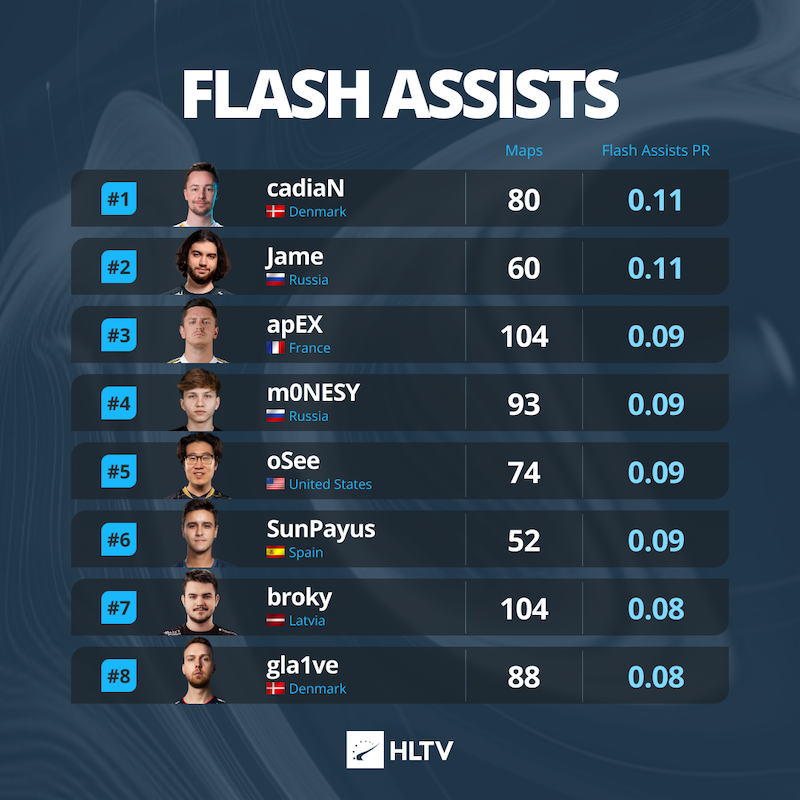
The list is dominated by AWPers and IGLs, a logical result. AWPers generally play from the back of the pack, throwing utility such as flashbangs to support their riflers before they activate themselves, usually later in the round. IGLs, too, often take supportive positions with AWPers that let them focus on the radar and their calls rather than their crosshair.
Combine both roles, and you get Casper “cadiaN” Møller and Dzhami “Jame” Ali, two AWP-IGLs who are consistently elite across most flash statistics. Ilya “m0NESY” Osipov is in fourth place, which is no surprise to those who have watched his stream or demos, where the young AWPer is always showing off new tricks for utility, whether it be yet another one-way smoke in Mirage window or a precise pop-flash.
However, flash assists do not tell the full story. With any stat, we must always equate for opportunity before comparing a player to someone else. This sounds complicated, but chances are you do it already.
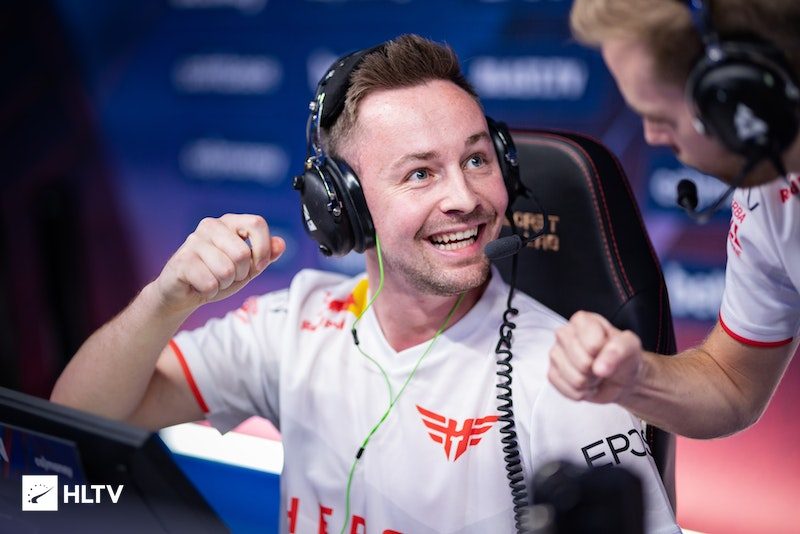
AWPing IGLs like cadiaN are generally elite across most flashbang statistics
In football, a striker is expected to score more goals than a defender, so to equate for a player’s opportunity to score goals, we would not take a striker scoring more goals than a defender as proof that the striker is a superior player. Ten goals for a defender is remarkable, but pretty average for a striker.
The same is true in CS. A support player’s 1.00 rating is actually pretty decent, but alarm bells should ring if your AWPer is around that range. Similarly, a 1.30 rating in a single map is pretty good, but a 1.30 rating over an entire year is a god-like level few have reached. So, there is a need to equate for opportunity, including ensuring similar sample sizes and the advantages a player’s role might give if we want to find out who throws the best flashbangs.
One answer is to go further than dividing a player’s flash assists by rounds, to instead divide it by total flashbangs thrown. Now, we can see what percentage of a player’s flashbangs directly lead to the death of an opponent. This makes it fairer, since a player who needs to buy an HE grenade every round (thus throwing fewer flashbangs) is still rewarded for having effective flashes relative to his role.
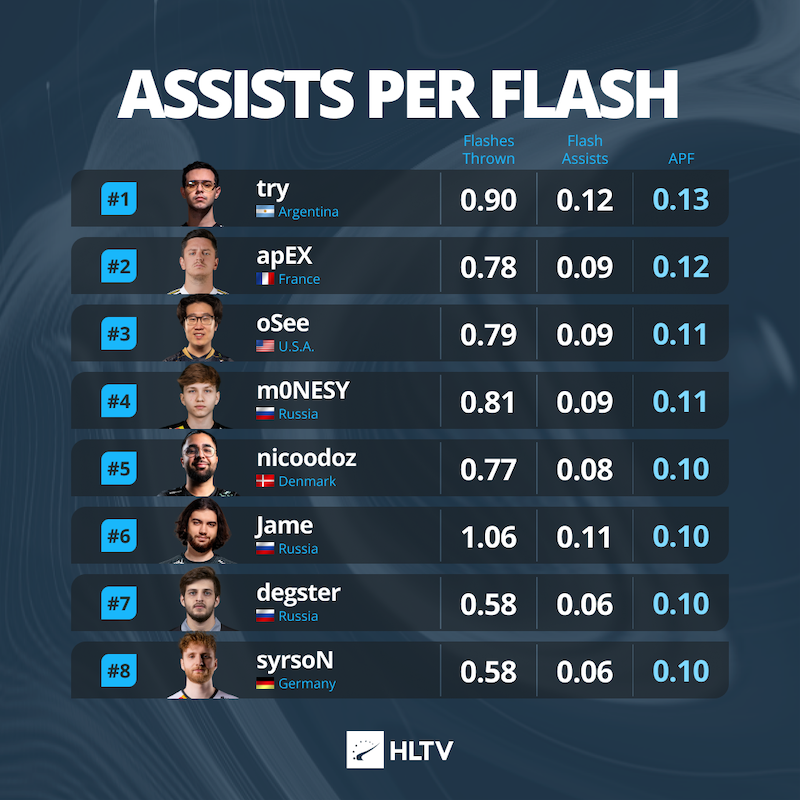
This is better, though it brings problems into the metric that did not exist before. Like a 1.30 rating over a year is more impressive than over a map, a high percentage of effective flashes is more impressive the more flashbangs a player throws. For that reason, flash assists per flash thrown should not entirely replace flash assists per round.
But, should we be using flash assists at all? HLTV’s flash assist statistic is more strict than Valve’s, with a scaling threshold based on how long a player was blinded for. This means that if a player was blinded for three seconds, any kill within those three seconds counts as a flash assist. This is useful in terms of accuracy, but it also means that flash assists are harder to get compared to in-game statistics.
When something happens only once every ten rounds — and that figure is generous, 0.10 flash assists per round is very impressive — it makes it harder to establish differences between players. The same problem is true when it comes to 1vX clutches, which is why our leaderboard for clutches does not account for rounds played.
Flash assists are also several steps divorced from the flashbang itself. A teammate can whiff on a completely blind player, netting you 0.00 flash assists per round. An opponent can get lucky and net a kill while fully blind. Your flash might fulfill a different purpose than a flash assist, perfectly delaying an enemy’s push for a crucial three seconds to allow a rotation to come in.
Flashes are versatile and their effectiveness is not completely covered by flash assists. Fortunately, it is not our only option: there is also the stat labelled as ‘opp flashed’ on our flashbang page. This is the average time per round opponents were blinded by a player’s flashbang. So, it takes into account good flashes even if they do not result in a kill.

cadiaN is still near the top, but a player like Dmitry “sh1ro” Sokolov drops out of the top ten with just 1.66s opponents flashed. This is where these stats can help with narratives; sh1ro‘s Cloud9 side have come under fire for their poor flash assists as a team, often coming low in the FTU leaderboard with just 0.19 flash assists per round. To put that into context, cadiaN gets a flash assist as often as Cloud9‘s whole team gets two.
So what explains this discrepancy? Heroic‘s proactive style, especially on CT-side, might put them in more situations where a popflash from cadiaN is useful compared to Cloud9‘s pragmatic, turtle-like approach to defence. But it also might be as simple as Cloud9 and sh1ro buying less flashes than other top teams — every statistic needs context to go along with it.
One avenue here is to equate for opportunity even further, by only comparing a player to their teammates. Here are the players who provide the highest percentage of their team’s flash assists:
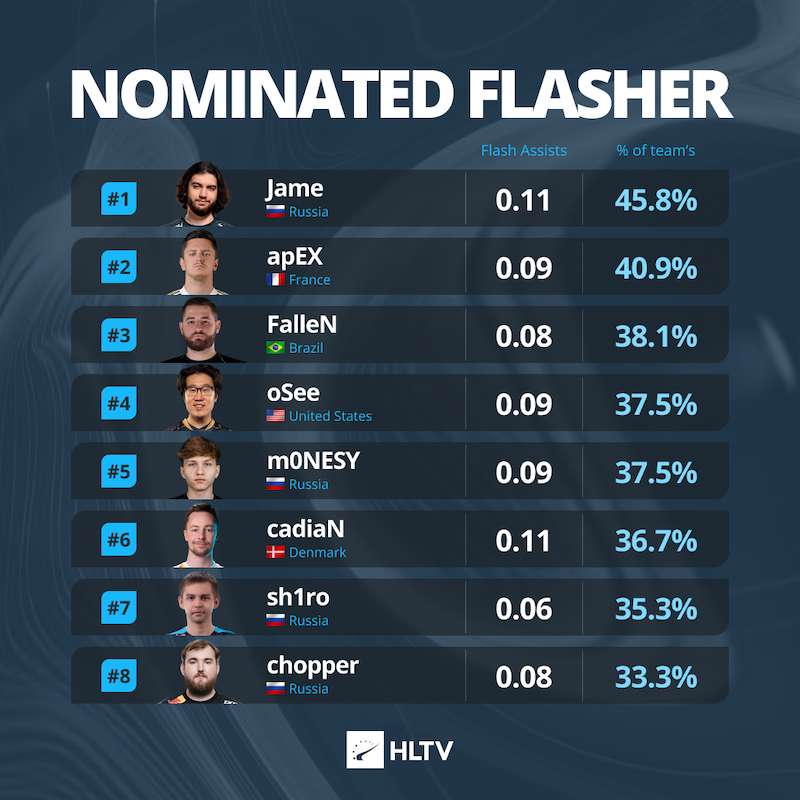
This list only includes players who have competed under the same banner for the entirety of 2022, excluding the likes of SunPayus
While interesting, this still doesn’t solve our problem. There is no single flashbang statistic that accounts for all of the issues raised in this piece. However, that isn’t that rare in stats. In fact, many a statistic needs to be presented in conjunction with another. We often do this automatically, like how 0.80 kills per round equals 24 kills in a 30 round game or how rating compiles several different metrics to make one easy-to-understand number.
But, sometimes, compiling multiple stats into one number is less valuable than keeping them seperate. Each stat might give you a slice of context, but only when viewed together do you get a full picture of how each stat affects the other.
To visualise this, here’s a scatterplot. On one axis is how many flashbangs each player throws per round, and the other shows how many seconds an opponent is blinded by that player’s flashbangs in each round.
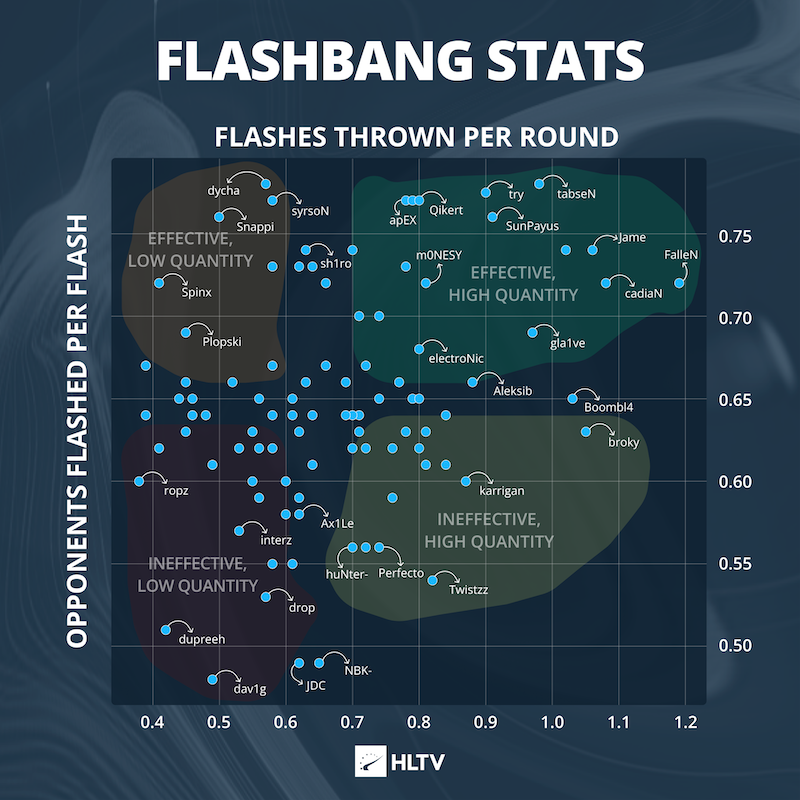
Now, we are viewing the numbers with proper context. The top-right corner shows the players who are elite with flashbangs whilst under a far larger sample size, while players like Marco “Snappi” Pfeiffer and Lotan “Spinx” Giladi are in a different zone for players who have very effective flashes but don’t throw too many.
We could do this for any flashbang statistic, of course; it would be equally valuable to see flash assists compared to time opponents were flashed, to see whose flashes are converted most often.
Hopefully we have illustrated the difference between viewing a statistic in isolation and with proper context. Before we finish the article, we will add one more caveat: we still cannot statistically determine who throws the best flashbangs. We have already mentioned the constraints when it comes to AWPers and supportive, back of the pack, players getting to throw more flashbangs.
But we are also missing a key part of the puzzle: Who found the lineup for the flashbang? Who designed the execute that the flash is part of? While it is often an IGL, coaches and analysts deserve credit for their team’s and player’s flashbang statistics too.
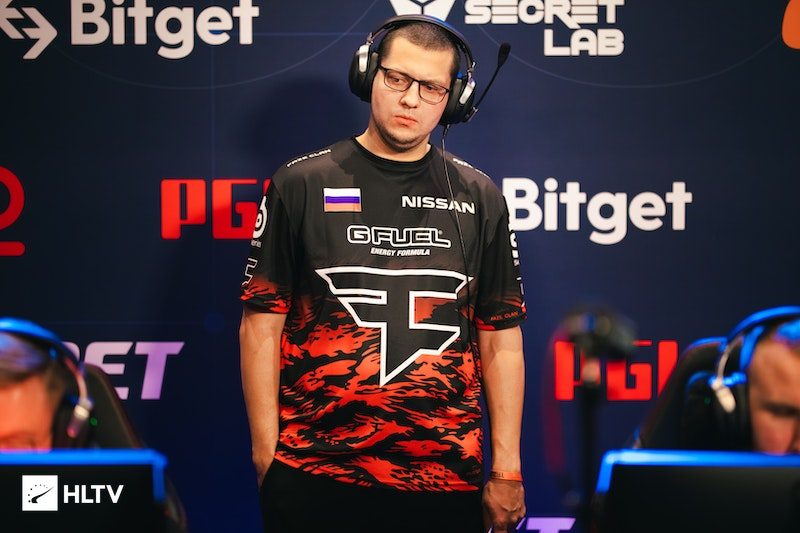
Backroom staff like FaZe’s innersh1ne are instrumental in finding new grenades for their teams
A player like cadiaN crops up across all metrics, so he is clearly doing something different to other players. But, from the outside, we cannot be 100% confident that edge is not boosted by analysts, style, and countless other factors.
This means it should be fairer to compare teams, rather than players, when it comes to flashbang statistics. Except, teams that score highly in flash assists are rarely the very best teams in the world.
In fact, there is a weak negative correlation between a team’s flash assists and round win percentage. Of the eight FTU stats (mutli-kills, opening kills, etc.) flash assists is the only one where our trend line slopes downwards.
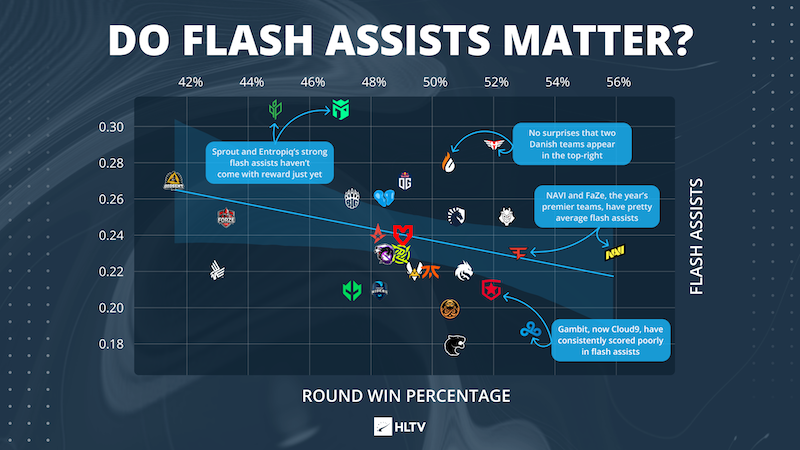
Teams like Cloud9 have had consistently poor flash assists, and the first scatterplot showed how FaZe‘s players actually seem to waste a lot of flashes, with Robin “ropz” Kool, Finn “karrigan” Andersen, and Russel “Twistzz” Van Dulken all in the yellow quadrant. This leads us to a crossroads: Are the best team in the world bad with their flashbangs? Or are we missing something?
The latter answer seems more likely. FaZe are an international squad, with an explosive style. Their rounds are quite short, leaving them less time for lined-up perfect god flashes. FaZe, plotted against every squad, are actually quite average for flash assists; it is multi-kills, 5v4 conversion, and 4v5 conversion that they excel in.
This is an important caveat to acknowledge before the final part of the article, where we take everything into account to create a ‘flash rating’ akin to opening kill rating, impact rating, and rating 2.0. Flashbang statistics, at the moment, cannot include all the necessary context.
Teams do not want every flashbang they throw to blind an enemy for three seconds or get an assist; the grenade is part of the cat-and-mouse, fake-heavy, meta. So, this is not a definitive list of the best flashbang throwers, nor is it trying to be. It is just a compilation of players who are consistently excellent across these three metrics:
— Flashbangs thrown per round
— Average time opponents were flashed per round
— Flash assists per round
Still, the formula goes a bit of the way to painting an overall picture of how well a player uses their flashbangs, with players like cadiaN, Jame, and Gabriel “FalleN” Toledo rewarded once again. Our AWP-IGL trend is seen once again, while five IGLs and six AWPers make the final list. But, do not forget that the impact of many a flashbang is not incorporated into this rating.
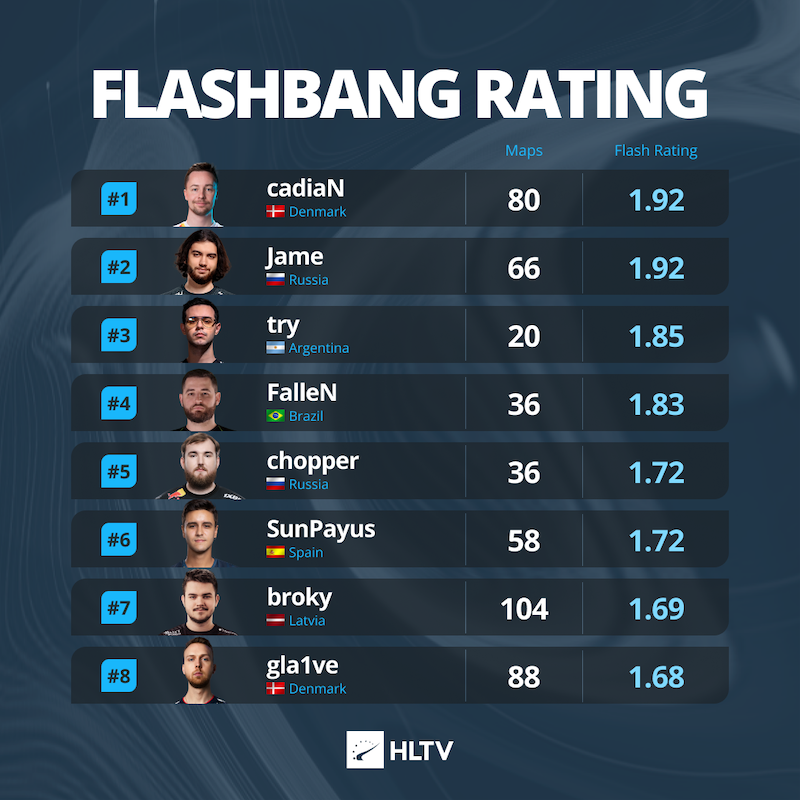
So, should we use flashbang statistics more? Perhaps; players like cadiaN clearly have a knack with the $200 grenade and deserve credit for doing so. But, their purpose should remain as an indicator of style: These statistics tell us that cadiaN uses his flashes to get assists and blind his opponents, but that is not the only possible use. Having a low rating does not mean a player is using his flashbangs incorrectly. Like any stat, context is king. And that is a lesson that can be applied across all metrics, not just those that concern flashbangs.
- alpha metaverse
- battlebots
- blockchain
- blockchain conference esports
- coingenius
- crypto conference esports
- esport games
- esporta
- esporta app
- esporta fitness
- esports
- evil geniuses
- games with esports
- globo esporte
- HLTV
- loco esports games
- metaverse esport games
- national sports week
- plato
- plato ai
- Plato Data Intelligence
- Plato Game
- PlatoData
- platogaming
- simplicity esports
- spasm esports games
- steam esports games
- team solomid
- top esports games
- tundra esports
- twitch esports games
- zephyrnet



![EliGE: "We actually scrapped everything that we had from before [IEM Cologne]" EliGE: "We actually scrapped everything that we had from before [IEM Cologne]" PlatoBlockchain Data Intelligence. Vertical Search. Ai.](http://platoblockchain.com/wp-content/uploads/2022/07/rl4YMJpxQXXj38gVzzN4Pu-300x200.jpg)








